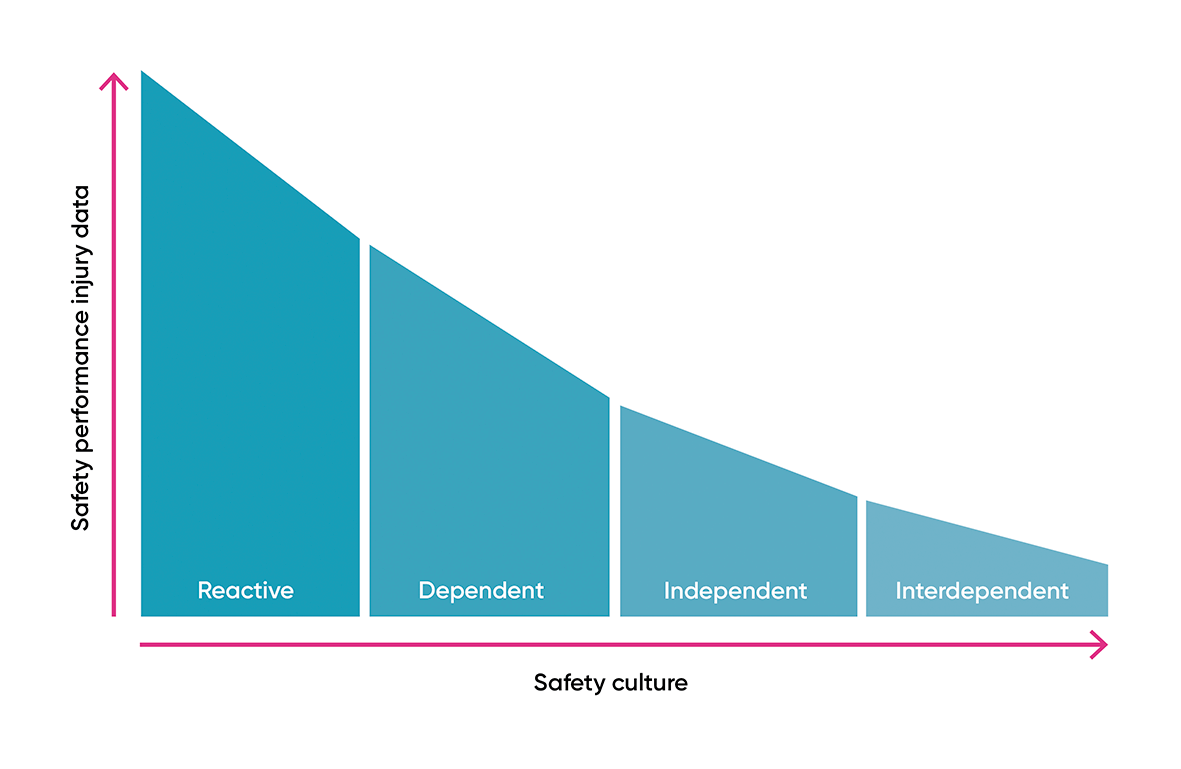Communicating through the curve: strategies for each stage of the Bradley Curve
In the pursuit of safety excellence or just improved safety performance, you may find yourself traversing the Bradley Curve — a model that outlines the stages of safety performance evolution: reactive, dependent, independent and interdependent. Each stage presents unique challenges, but by integrating Stephen Covey's '7 Habits of Highly Effective People', safety professionals can employ time-tested and proven communication strategies to guide their teams towards a culture of safety. Let's explore these stages and the corresponding habits:

Reactive stage
Communication focus: Be proactive (habit 1)
In the reactive stage, incidents drive safety discussions. Safety professionals must proactively address immediate concerns by promoting a proactive safety mindset. Initiate conversations with workers of all levels about hazard identification, risk assessment and the importance of individual and community responsibility in preventing injuries and incidents through identification and correction of unsafe conditions. Encourage employees to report near misses and unsafe conditions and provide feedback on safety concerns.
Safety professionals can conduct regular safety meetings to discuss potential hazards, share lessons learned from incidents, and emphasize the importance of taking proactive measures. Encourage employees to voice concerns and suggestions for improvement, fostering a culture where safety is a shared responsibility.
Dependent stage
Communication focus: Begin with the end in mind (habit 2)
As the organization progresses to the dependent stage, set clear safety goals and communicate a vision for a safer workplace. Define safety expectations and help employees understand how adhering to safety protocols aligns with the organization's long-term success. Establish a shared commitment to safety goals, emphasizing the collective impact of individual contributions.
Use visual aids, such as safety performance charts and success stories, to create a compelling narrative. Involve employees in the development and creation of performance reporting to ensure it is meaningful. Repeat these exercises as performance improves and specific factors need to be fine-tuned.
Independent stage
Communication focus: Put first things first (habit 3)
In the independent stage, effective communication involves prioritizing safety within daily operations. Safety professionals should collaborate with team leaders, managers, supervisors and directors to integrate safety into the job tasks and routines of their direct reports. Emphasize the intrinsic value of time invested in safety activities, conveying that prioritizing safety not only prevents accidents but also contributes to overall efficiency. Communicate the concept that safety is not an additional task but an integral part of every job function.
Interdependent stage
Communication focus: Think win-win (Habit 4), seek first to understand, then to be understood (Habit 5) and synergize (Habit 6)
At the interdependent stage, safety becomes ingrained in the organization's culture. Safety professionals are viewed as the trusted advisor as they continue to foster a collaborative environment where safety is everyone's responsibility. Communicate the concept of 'win-win,' where safety benefits both individuals, the organization, and the greater community. Practice empathetic listening to understand diverse perspectives on safety. Encourage the sharing of best practices and lessons learned to continuously improve safety processes. Further synergize efforts by creating cross-functional safety teams that leverage the collective expertise of the teams.
Ongoing improvement
Communication focus: Sharpen the saw (Habit 7)
As the organization focuses on ongoing improvement, safety professionals should communicate the holistic nature of safety. Communicate the importance of regularly renewing and revisiting safety practices as lessons are learned. Encourage continuous learning, regular safety training and the incorporation of new safety technologies. Emphasize the importance of physical, mental, and emotional well-being to sustain a culture of safety. Encourage a collective mindset that views safety as a dynamic, evolving aspect of the organizational culture, requiring constant attention and improvement.
Conclusion
By incorporating these communication strategies at each stage of the Bradley Curve aligned with Covey's 7 Habits, safety professionals can guide their organizations towards an advanced safety culture. It is not just about compliance; it's about fostering a mindset where safety is not just a priority but an integral part of the organization's foundation for safety excellence. As organizations evolve along the Bradley Curve, effective communication becomes the key catalyst for creating sustainable and interdependent safety excellence.
Nicola spends her days thinking about how teams work better together —and how we can make document collaboration a little less painful with technology. She's particularly interested in helping teams within highly regulated industries, where data security and compliance are paramount, to streamline their processes and boost efficiency.


